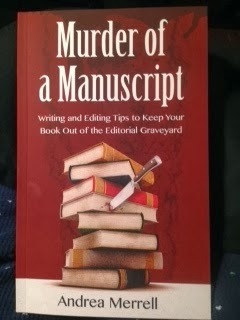Turning Publishing Rejection into Acceptance
 Andrea Merrell is a good friend of mine and an AMAZING editor. I asked her to share some of the things that stand in the way of acceptance when a writing submits a manuscript.
Andrea Merrell is a good friend of mine and an AMAZING editor. I asked her to share some of the things that stand in the way of acceptance when a writing submits a manuscript.She's been a guest here on The Write Conversation before, but now that she has a book out for writers I persuaded her to come back.
I predict that MURDER OF A MANUSCRIPT is going to become one of those must-haves for writers. It's published by Lighthouse Publishing of the Carolinas and now available on Amazon. Personally, I give it a 5-star rating!
TURNING REJECTION INTO ACCEPTANCEby Andrea Merrell
 No one likes to be rejected. Unfortunately, when you’re a writer, it comes with the proverbial territory. The key is to keep perfecting your craft—and keep submitting.
No one likes to be rejected. Unfortunately, when you’re a writer, it comes with the proverbial territory. The key is to keep perfecting your craft—and keep submitting. When I first started writing, I simply put what was in my head (and my heart) on paper. I had no clue how to format my words and had never heard of things like: hooks, POV, showing-not-telling, backstory, and syntax. Therefore, my first submission met with immediate rejection. Ouch! Second submission—same scenario. I simply wasn’t ready.
Was I tempted to give up? Absolutely. Fortunately, I was blessed with some great advice—the best advice I’ve ever received as a writer: “Find a critique group, attend writers’ conferences, and network, network, network.” (Thank you, Vonda Skelton!)
The problem with most rejection letters is not what they say, but what they don’t say. Instead of giving you constructive criticism and suggestions for improving your work, most simply state: Sorry, your submission does not meet our requirements at this time.
So, what are those requirements? What does an agent/editor/publisher really expect? Speaking as an editor and member of a pub-board, these are some of the elements I look for when I review a submission:
 Quality of the writing.The writer’s voice.Did the first sentence or paragraph hook me?Is the formatting correct?Is the first page filled with typos?Does the writer have a good grasp of grammar, punctuation, and spelling?Does the writer show or tell the story?How does the writer handle backstory?Is there a natural flow?Is the content preachy?
Quality of the writing.The writer’s voice.Did the first sentence or paragraph hook me?Is the formatting correct?Is the first page filled with typos?Does the writer have a good grasp of grammar, punctuation, and spelling?Does the writer show or tell the story?How does the writer handle backstory?Is there a natural flow?Is the content preachy?Whether just starting out on your writing journey, or a seasoned author, make it your goal to master these points so your submission will make it past someone’s inbox. Know the basics. Edit and proofread your work (bio, query letter, synopsis, proposal, manuscript, and—yes—even your e-mails).
Bottom line: make sure your words are as clean and professional as possible before you send them into cyber space. You will be glad you did.
 Andrea Merrell is a freelance writer and editor living in the beautiful upstate of South Carolina. She is Associate Editor for Christian Devotions Ministries and Lighthouse Publishing of the Carolinas. Andrea has led workshops at the Kentucky Christian Writers Conference (KCWC), Writers Advance Boot Camp, and The CLASS Christian Writers Conference in New Mexico. Her work has been published online and in numerous anthologies. Andrea’s next book, Praying for the Prodigal, will be released by Lighthouse Publishing of the Carolinas in 2015. To learn more about her, visit her website: www.andreamerrell.com.
Andrea Merrell is a freelance writer and editor living in the beautiful upstate of South Carolina. She is Associate Editor for Christian Devotions Ministries and Lighthouse Publishing of the Carolinas. Andrea has led workshops at the Kentucky Christian Writers Conference (KCWC), Writers Advance Boot Camp, and The CLASS Christian Writers Conference in New Mexico. Her work has been published online and in numerous anthologies. Andrea’s next book, Praying for the Prodigal, will be released by Lighthouse Publishing of the Carolinas in 2015. To learn more about her, visit her website: www.andreamerrell.com.
TWEETABLESLearn how to turn publishing rejection into acceptance - via @AndreaMerrell on @EdieMelson (Click to Tweet)
Do you know what editors look for when you submit a manuscript? answers via @AndreaMerrell on @EdieMelson (Click to Tweet)
Published on January 28, 2014 01:00
No comments have been added yet.



